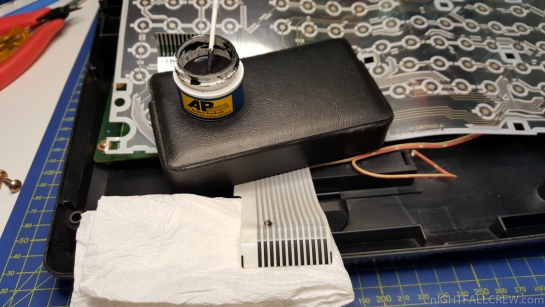
I used a product to regenerate the rubber keypad of remote controls to repair the keyboard flat cable of a Home Computer MSX.
I have used this product many times for my work of Retro Computer restoration but never to regenerate the rubber keypad of remote controls :D
Gallery of the repair:
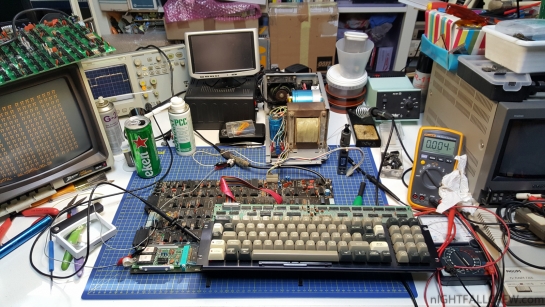
Below the description of the repairing of two Processor Technology SOL-20.
Processor Technology SOL-20 #1 Repair
Defect:
First of ALL!
- You should never replace CD4029 with HCF4029 although apparently could work and maybe it works .. on some motherboard could do bizarre defects or video glitches, like a split screen!
Components replaced and fixes:
- Replaced all IC series HCF 4XXX HCF with the right CD 4XXX series.
- Sprayed DUE-CI G-22 on all Texas Instruments IC sockets.
- Replaced wrong ic 74LS157 in place of a 74LS367 (U29)
- Rebuild broken pcb track near the caps (C15)
- Replaced wrong capacitor of 22uf in place of a 1uf (C67)
- Rebuild bridges under the IC U46 that has seen better days.
- Replaced Capacitor (C31)
- Remake cold welding on the PSU connector and the socket of CPU Intel 8080A.
- Removed a little piece of solder under a socket (see photo)
- Replaced 74LS138 (U34) dead without reason while typing this text on the SOL-20 (FUCKKKK!!!!!!!!!)
… Some Beers… :-D
Gallery of the repair:
Processor Technology SOL-20 #2 Repair
Defect:
First of ALL!
- You should never replace CD4029 with HCF4029 although apparently could work and maybe it works .. on some motherboard could do a bizarre defects or video glitches!
Components replaced and fixes:
- Replaced all IC series HCF 4XXX HCF with the right CD 4XXX series.
- Sprayed DUE-CI G-22 on all Texas Instruments IC sockets.
- Cleaned the motherboard and connectors with Kontakt PCC (Printed Circuits Cleaner)
- Temporarily removed the IC 74LS136 (U22) which put in short-circuit the personality card and burned the 74LS04 (U24). Probably this is a “homebrew” modification for a particular Personality card.
- Replaced wrong ic 74LS04 (U23) in place of a 74LS20 (U23)
- Replaced RAM 2102 (U15)
Note:
- Many sockets not of the Texas Instruments completely rusted are previously been replaced by the owner of this computer (Alessandro Polito).
Gallery of the repair:
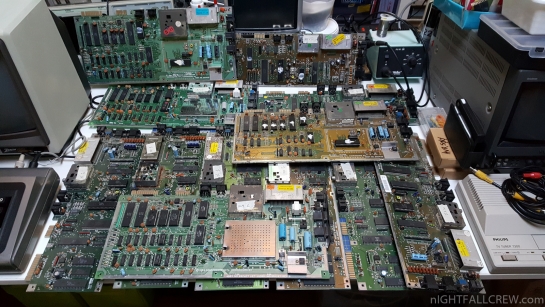
Commodore 64C (ASSY 250469) Repair (1 of 12)
Defect:
Replaced parts:
Gallery of the repair:
Commodore 64C (ASSY 250469) Repair (2 of 12)
Defect:
Replaced parts:
Gallery of the repair:
Commodore 64C (ASSY 250469) Repair (3 of 12)
Defect:
- Black Screen.
- Keyboard Dead.
Replaced parts:
- 2 x TMS 4464 (U10/U11)
- 1 x MOS 6526 (U1)
Gallery of the repair:
Read more…
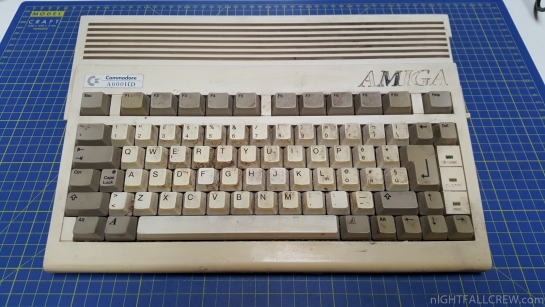
The motherboard conditions are not good, very badly. All capacitors have released acid, some are gone and the same for other components like the transistor Q233 2N3904 SMD amplifying for the video signal BLUE RGB. The Decoder U12 CXA1145 Sony has the pins eaten by the acid of the capacitors.
Poor Amiga …
Work to do:
- Solder resistance from E232R that is disconnected because the acid of the capacitors has leaked and corroded..
- Solder the transistor Q233 that is disconnected because the acid of the capacitors has leaked and corroded.
- Rebuilding a dozen pf pcb track between the IC U12 and the rest of the PCB and rebuilding also the through holes of the PCB.
- Replacing electrolytic capacitors, probably due to the state of the pitches i don’t use SMD capacitors.
- Replacing the male Harddisk connector some legs are broken at the base because the acid of the capacitors has leaked and corroded.
Gallery of the repair & cleaning:
I start to saying that this type of repair should NOT be made, are not good although the repair can succeed, these damaged motherboards are good for spare parts.
It took me 10 hours to repair and if i ask 15,00 euro per hour like a housekeeper, would be 150,00 euro excluding components and cleaning case … but who pays 150,00+ euro ? no one in the world. :-D
This is one of the reasons because do not exist anymore electronic repairs or there are very few people can do it, nobody is willing to pay.
Works that have been made:
Foreword almost all pcb pads are leaked of the acid, although i have cleaned more times so as not to heat the electrolyte liquid that is worsening the situation, unfortunately the pcb pad could not resist to a new solder and they are broken.
- Soldered the E232R resistor, it’s no a good soldering because the pad are in a badly state but working.
- Soldered a transistors Q233 (2N3904) not SMD, the pitches are gone when i have tried to solder the SMD version.
- Rebuilt 10 x connections doing a horrible jumpers in bizarre places.
- Replaced the electrolytic capacitors.
- Replaced the male connector for the Harddisk.
It’s a shit … but it works!
Commodore Amiga 600 Gallery (Before & After):
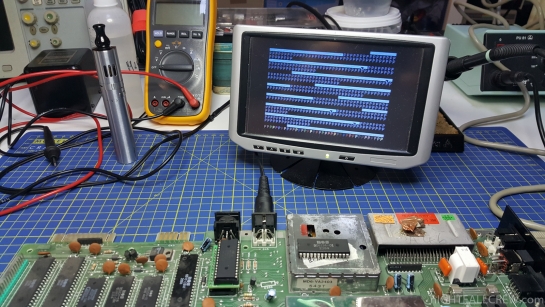
Yet another Commodore 64 (USA-NTSC) repaired.
Defect:
- Garbage screen / Black screen.
Repair:
- Replaced 1 x PLA 906114
- Replaced 1 x MOS 7708 (74LS257)
Note:
- The first time the Garbage Screen was in Black & White and then after replacing the PLA 906114 a new Garbage Screen is back with some colors :-D (see photo)
Gallery of the repair:
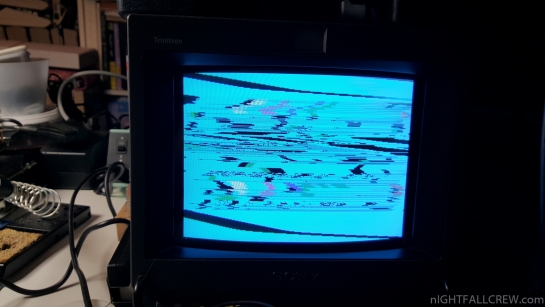
Texas Instruments TI-99/4A Repair (#1)
Defect:
Replaced parts:
- 1 x Variable Inductor 2 -> 4.5 μH (L100).
Gallery of repair:
Texas Instruments TI-99/4A Repair (#2)
I should point out that someone has already tried to repair, without success.
Defects:
- Black Screen (no raster, no sync) short circuit between 12v and 5v . . . and then . . .
- Wave/Raster Lines.
- Blue Screen with tiny Vertical lines and deafening sound.
- Garbage Screen.
Short Circuit Note:
- The short circuit was due to a malfunction of the IC: TIM9904ANL (U601)
Replaced parts:
- 1 x Variable Inductor 2 -> 4.5 μH (L100).
- 1 x TIM9904ANL (U601)
- 2 x MCM 6810P RAM 128×8 (U608 – U609)
- 1 x 74LS245 (U614)
- 1 x TMS9929 (U100)
Gallery of the repair:
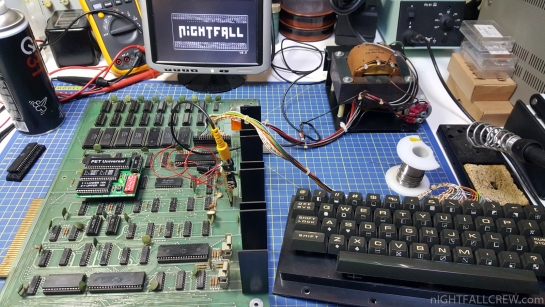
Commodore PET 2001 Chiclet (1978) Fixed.
Defect:
Repair:
The problem of this computer was caused by the oxide on all pins of the RAM and inside of the sockets as you can see from the photos.
To clean the pins of the IC i always use the same way, gently with a rasp nail on the ic pins and then spray a bit of air, see photo.
For cleaning the socket i scraping with a fine tip gently the contact inside the socket.
I have tested all with the ROM/RAM board and simulating the various BASIC and configurations of RAM and loaded some software, including my demo with the PET MicroSD by Dave Curran (Tynemouth Software)
Everything worked perfectly.
As you can see from the photos i have now a complete workstation for repair PET 2001 out of the box, avoiding to have on the table the computer that takes a lot of space.
Gallery of the repair:
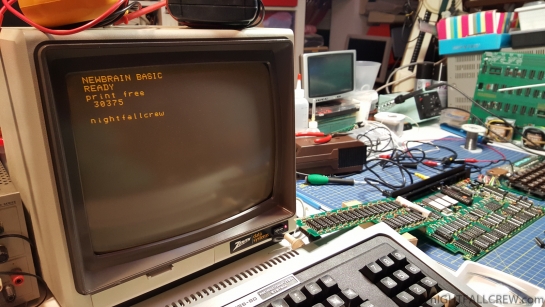
Grundy Newbrain repaired
Defect:
Analysis:
- The acid of the capacitors has corroded some pcb tracks and pitches of the main pcb.
- One of the two flat cable (main pcb -> keyboard/vfd pcb) previously repaired cause short circuits and doesn’t work.
- Removing the Filter capacitor “RIFA” in the external PSU (removal made 7 months ago)
Repair # 1:
- Replaced all the electrolytic capacitors.
- Rebuild the PCB tracks corroded by the acid of the capacitors.
- Replaced the flat between the main PCB and the keyboard/vfd pcb.
The computer now turns on but the VFD (Vacuum Fluorescent Display) displays weird characters and the composite video signal is dead.
Repair # 2:
I have used a Z80 NOP generator that i have made some years ago for repairing ZX Spectrum/Sinclair and that causes the Z80 to process only “NOP” instructions
and consequently on the address lines we can see with a oscilloscope a perfect square wave.
With this simple “trick” i have immediately found the faulty component that break one of the address lines of the CPU (A1). The exact same fault was found by Thomas Gutmeier.
- Replaced 1 x 74LS257 (IC 412)
The computer now works perfectly.
Gallery of the repair:
Download: Grundy NewBrain Schematics (1495)
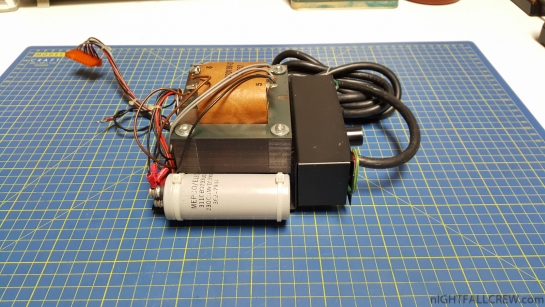
Laboratory Bench Transformer for repair Commodore CBM/PET series 2001/30xx/40xx(not fat – 8032 motherboard)
Transformer Output Pinout:
- PIN: 4 – 6 = ~16VAC
- PIN: 4 – 5 = ~8VAC
- PIN: 5 – 6 = ~8VAC
- PIN: 7 – 8 = ~16VAC
- PIN: 9 – 10 = ~16VAC
Input:
Gallery:
Thanks to Andrea Pierdomenico for this great donation made some years ago.

2 x Commodore Amiga 600 Full Recap and Repair.
Commodore Amiga 600 #1:
- Full SMD Capacitors Recap.
- Replaced the joystick port with a missing two pins. The joystick port has been recovered from a pcb (not amiga) for spare parts.
Gallery:
Commodore Amiga 600 #2:
- Full SMD Capacitors Recap.
Gallery:
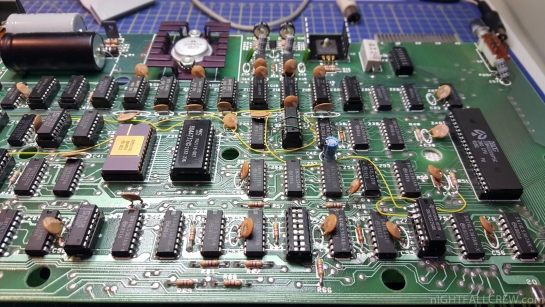
TRS-80 Model 1 L2 – Video Snow Shovel Hardware Fix
Video snow, the black streaks against white characters, is most apparent with large, rapidly changing areas of white graphics. The root of the problem is that the TRS-80 display is memory mapped by the CPU.
The solution is to give the video circuitry higher priority than the cpu.
Note:
On my TRS-80 Model 1 where i use the Quinnterface & FreHD i had to use the version that also includes the 74LS125 which seemed optional but in this case it does not appear to be optional, we have to do it, otherwise doesn’t work.
Thanks to Ian Mavric for the support.
Gallery of the hardware mod:
Download: 80 Microcomputing Magazine 1982 (829)
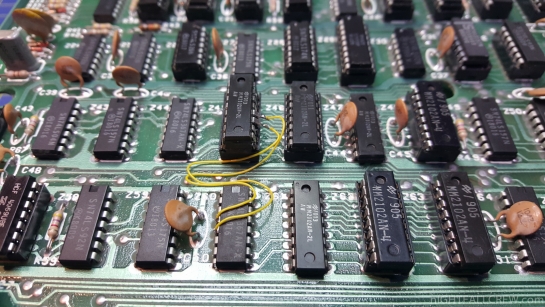
One of the most famous limitations of the TRS-80 Model I was its inability to display lower case characters.
Although the lower case characters were present in the character set, the Model I lacked the extra memory chip needed to store the bit corresponding to lower case.
The significance of this limitation has been exaggerated over time (it is worth noting that at that same time the Apple II also lacked lower case), but it created a real problem for word processors. Many lower case upgrades for the Model I were created to address the omission, ranging from simple to more complex.
The TRS-80 video display uses a dedicated block of 1024 bytes of memory located in memory space at 3C00 Hex. When received from the factory, there are only 7 memory chips installed in this block of memory, providing 128 possible characters for screen display. The stock TRS-80 uses 64 of these combinations for graphics and a second 64 for the upper-case subset of the ASCII character set. Bits 0-5 control the character selection, and the highest bit (bit 7) is used to determine if the character is alpha-numeric or graphic. Bit 6 is missing!
To add lower-case display, bit 6 must be implemented. This may be accomplished by switching the memory chip for bit 7 to bit 6, thereby enabling lower-case letters and eliminating graphics, or by addition of an 8th memory chip. We prefer adding the extra chip. In either case, if you plan to use Level II BASIC, you must include a switch to disable bit 6, or BASIC will place a lot of funny characters on the screen!
Gallery of the hardware mod:
Download: Lowercase characters Hardware mod (1066)
source: trs-80.org
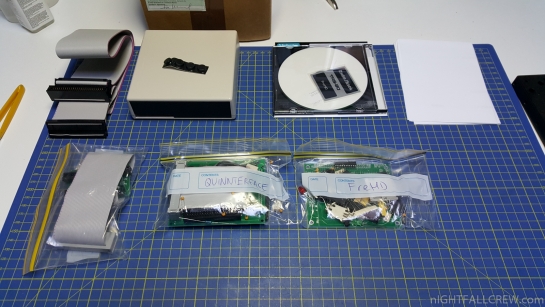
TRS-80 Interfaces in KIT from Ian Mavric and J. Andrew Quinn.
I begin to assemble the kit:
- “Quinnterface” is a Mini Expansion Interface for TRS-80 Model I with 16K. Neat little device is perfect for Model I users who own a 16K Level II unit (which is most of you) but no EI or Disk Drives, and don’t want to modify your Model I with upgraded boot Rom or memory upgrade. The Quinnterface, developed by J. Andrew Quinn from New Zealand, adds 32K RAM and auto-boot functionality to your FreHD.
- “FreHD” SD Card HARD DRIVE Emulator for TRS-80 Model I/III/4.
The complete kit consists:
- Quinnterface.
- FreHD.
- Model 1 Hard Drive Adapter.
- BoHx. A small neat enclosure for your FreHD!
- CD ROM / Stickers and Cables.
Gallery:
source: ianmav.customer.netspace.net.au/trs80/
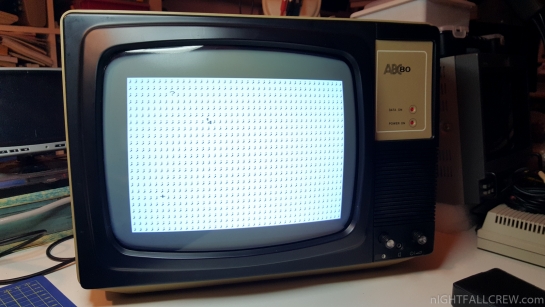
Defects:
- Some keyboard keys are totally dead.
- Missing +17v and obviously the +12v
- Short-circuit on the psu side, inside the monitor.
- Tape Recorder with the mechanism stucked.
Repairing:
- Replaced most of the Tantalum Capacitors* on the main pcb and on the tape recorder pcb, some are in short-circuit.
- Replaced 1 x Fuse on the CRT Monitor pcb side.
- Repair Tape Recorder, i had to disassemble most parts of the tape recorder mechanism. The lubricant grease was dry and has totally blocked the mechanism of the tape recorder.
- Replaced all pads (Foam Mylar Pad) of the Keytronics Keyboard, the same Keyboard used in SOL-20.
* For this repair i have used only tantalum capacitors, although i usually prefer to use electrolytic capacitors, i used to keep the same aesthetic.
Gallery of the repairing:
Download:




Recent Comments